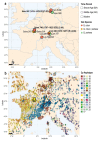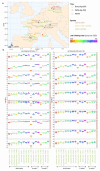Tracking population structure and phenology through time using ancient genomes from waterlogged white oak wood
- PMID: 36748324
- PMCID: PMC7615563
- DOI: 10.1111/mec.16859
Tracking population structure and phenology through time using ancient genomes from waterlogged white oak wood
Abstract
Whole genome characterizations of crop plants based on ancient DNA have provided unique keys for a better understanding of the evolutionary origins of modern cultivars, the pace and mode of selection underlying their adaptation to new environments and the production of phenotypes of interest. Although forests are among the most biologically rich ecosystems on earth and represent a fundamental resource for human societies, no ancient genome sequences have been generated for trees. This contrasts with the generation of multiple ancient reference genomes for important crops. Here, we sequenced the first ancient tree genomes using two white oak wood remains from Germany dating to the Last Little Ice Age (15th century CE, 7.3× and 4.0×) and one from France dating to the Bronze Age (1700 BCE, 3.4×). We assessed the underlying species and identified one medieval remains as a hybrid between two common oak species (Quercus robur and Q. petraea) and the other two remains as Q. robur. We found that diversity at the global genome level had not changed over time. However, exploratory analyses suggested that a reduction of diversity took place at different time periods. Finally, we determined the timing of leaf unfolding for ancient trees for the first time. The study extends the application of ancient wood beyond the classical proxies of dendroclimatology, dendrochronology, dendroarchaeology and dendroecology, thereby enhancing resolution of inferences on the responses of forest ecosystems to past environmental changes, epidemics and silvicultural practices.
Keywords: Quercus. robur; Q. robur × Q. petraea; admixture; bronze age; first tree paleogenomes; last little ice age; leaf unfolding timing.
© 2023 John Wiley & Sons Ltd.
Figures






Similar articles
-
High-Throughput DNA sequencing of ancient wood.Mol Ecol. 2018 Mar;27(5):1138-1154. doi: 10.1111/mec.14514. Epub 2018 Mar 3. Mol Ecol. 2018. PMID: 29412519 Free PMC article.
-
Ancient tree genomes for old questions.Mol Ecol. 2024 Feb;33(3):e17259. doi: 10.1111/mec.17259. Epub 2024 Jan 5. Mol Ecol. 2024. PMID: 38179684
-
Untargeted UHPLC-Q-TOF-HRMS based determination of discrimating compounds for oak species Quercus robur L. and Quercus petraea Liebl. identification.Phytochem Anal. 2021 Sep;32(5):660-671. doi: 10.1002/pca.3013. Epub 2020 Nov 16. Phytochem Anal. 2021. PMID: 33197960
-
How does contemporary selection shape oak phenotypes?Evol Appl. 2020 Aug 14;13(10):2772-2790. doi: 10.1111/eva.13082. eCollection 2020 Dec. Evol Appl. 2020. PMID: 33294022 Free PMC article.
-
Tracing the origin of wood at the regional scale with dendrochemical markers: elemental and strontium and neodymium isotopic composition.Sci Total Environ. 2024 Dec 20;957:177640. doi: 10.1016/j.scitotenv.2024.177640. Epub 2024 Nov 29. Sci Total Environ. 2024. PMID: 39566622
References
-
- Aguilera M, Ferrio Díaz JP, Araus Ortega JL, Tarrús J, Voltas Velasco J. Climate at the onset of western Mediterranean agriculture expansion: Evidence from stable isotopes of sub-fossil oak tree rings in Spain. Palaeogeography, Palaeoclimatology, Palaeoecology. 2011;299:541–551.
-
- Alberto F, Bouffier L, Louvet J-M, et al. Adaptive responses for seed and leaf phenology in natural populations of sessile oak along an altitudinal gradient. Journal of Evolutionary Biology. 2011;24:1442–1454. - PubMed
-
- Alberto F, Niort J, Derory J, et al. Population differentiation of sessile oak at the altitudinal front of migration in the French Pyrenees. Molecular Ecology. 2010;19:2626–2639. - PubMed
-
- Bacilieri R, Ducousso A, Petit RJ, Kremer A. Mating system and asymmetric hybridization in a mixed stand of European oaks. Evolution. 1996;50:900–908. - PubMed
MeSH terms
Grants and funding
LinkOut - more resources
Full Text Sources
Miscellaneous

